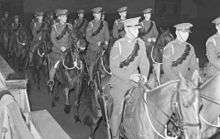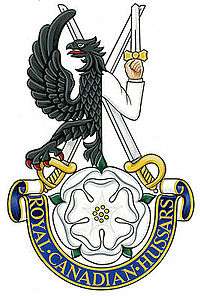The Royal Canadian Hussars (Montreal)
| The Royal Canadian Hussars (Montreal) | |
|---|---|
|
Cap badge of the Royal Canadian Hussars | |
| Active | 1877–present |
| Country | Canada |
| Branch | Canadian Army |
| Type | Line cavalry |
| Role | Armoured reconnaissance |
| Size | One under-strength regiment (approximately 90 soldiers) |
| Part of | 34 Canadian Brigade Group |
| Garrison/HQ | Montreal |
| Motto(s) | Non nobis sed patriae (Not for ourselves, but for our country) |
| March | "St. Patrick's Day" and "Men of Harlech" |
| Battle honours |
|
| Commanders | |
| Current commander | LCol Hlibchuk |
The Royal Canadian Hussars (Montreal) (abbreviated as RCH) is an armoured reconnaissance regiment of the Primary Reserve in the Canadian Forces. Its primary role consists of obtaining critical information about the belligerent as well as their surrounding terrain.
History
Lineage
The Royal Canadian Hussars (Montreal) derives from the Montreal Volunteer Cavalry (formed in the late eighteenth century). The present regiment perpetuates five cavalry units and one armoured unit: the Royal Montreal Cavalry, the 5th Dragoons, the 6th Duke of Connaught's Royal Canadian Hussars (6th DCRCH), the 11th Argenteuil Rangers, the 17th Duke of York's Royal Canadian Hussars (17th DYRCH), and the 1st Motor Machine Gun Brigade.[4][5]

It is also home to the 2nd Field Regiment, Royal Canadian Artillery
19th century
During the War of 1812, No. 1 Troop of Montreal Cavalry was raised to augment the regular forces and to perform screening and liaison duties. Based on its performance, the force was increased and authorized to assume the title The Royal Montreal Cavalry, which it continued to bear until, in 1855, it was absorbed into the newly formed Canadian Militia as the Montreal Squadron of Cavalry. The regiment's first guidon (the oldest in Canada) was presented in 1828 by the Earl of Dalhousie and currently resides in the RCH armoury.[6]
After Canadian Confederation, No. 2 Troop and the Royal Guides Troop of the Montreal Squadron were disbanded, leaving No. 1 Troop as the sole militia cavalry unit in Montreal. In 1877, the Dominion government grouped the independent troops positioned along the U.S. border. The 5th Dragoons (5th Provisional Regiment of Cavalry) was formed, the first cavalry regiment in Quebec. In 1879, a second regiment, the 6th Regiment of Cavalry (Hussars), which incorporated No. 1 Troop, detached to become an independent squadron, which, in 1898, was redesignated the 17th Duke of York's Royal Canadian Hussars.[6]
The South African War of 1899-1902 saw the 6th and 17th Hussars dispatch volunteers, which formed the 1st Canadian Mounted Rifles, subsequently winning the regiment's first post-Confederation battle honour.[6]
World War I and inter-war
On 6 August 1914, both the 6th Duke of Connaught's Royal Canadian Hussars and the 17th Duke of York's Royal Canadian Hussars ("Argenteuil Rangers") were placed on active service for local protection duty.
The nature of the Western Front gave rise to the need for motorized machine gun units. Canada's first armoured unit, 1st Motor Machine Gun Brigade, was formed and equipped with armoured cars. By the war's end it had earned 21 battle honours.[7] The 6th Duke of Connaught's Royal Canadian Hussars perpetuates the 1st Motor Machine Gun Brigade and shares its battle honours.[8]
In 1926 HRH the Duke of York (later to become King George VI) consented to become the colonel-in-chief of the regiment. In 1934, the present RCH armoury was built for the 17th DYRCH. It is the only cavalry armoury in Canada to incorporate both stables and a riding school. In 1936, the Canadian Militia was reorganized. The 6th DCRCH (inactive since 1920) was resurrected and amalgamated with the 1st Motor Machine Gun Brigade, to form an armoured car regiment.[7]
World War II


In 1939, the 17th DYRCH paid off their horses (the last Canadian cavalry unit to do so) and were mobilized, becoming successively the 3rd Canadian Motorcycle Regiment and the 7th Reconnaissance Regiment (17th DYRCH), or 7th Recce, of the 3rd Canadian Infantry Division.[9]
In 1941, the 6th DCRCH were called upon to furnish the Headquarters Squadron of the 5th Canadian Armoured Division and were designated 15th Armoured Regiment (6th DCRCH). In October 1943, the 5th Canadian Armoured Division landed in Italy and went into action in mid-January 1944. The 6th later moved to France in February 1945.[9]
In 1944, the 7th Recce participated in D-Day when members of B Squadron, tasked as beach exit parties and brigade contact detachments, landed on the Normandy beaches. The 7th campaigned through Europe earning 11 battle honours.[9]
Post-war
In 1945, a reconnaissance regiment was required for the occupation troops remaining in Europe. This unit was designated as the Second 7th (17th DYRCH) and consisted of volunteers from several other units. The original 7th Recce returned to Montreal.[9]
An amalgamation of the 6th DCRCH and the 17th DYRCH took place on September 16, 1958, when the newly formed regiment was given the current title of The Royal Canadian Hussars (Montreal).[9]
Since the amalgamation, the regiment itself has not been involved in any hostilities but has constantly provided individuals to augment the Regular Force in both NATO and United Nations peacekeeping duties[10] as well as domestic operations such as Operation Recuperation during the Ice Storm of 1998.
The regiment received its second guidon on December 3, 1974, the 100th anniversary of regimental status and its 135th year as a Canadian cavalry unit.[10]
One of the Hussars' former Commanding Officers, Lieutenant-Colonel (Retd) Roman Jarymowycz, O.M.M., C.D., later became Dean and Director of the Militia Command and Staff Course, serving as an instructor for 15 years.[11]
From 1986 to 1990, the regiment won the Royal Canadian Armoured Corps Buchanan Trophy (the best armour unit in the Eastern and Atlantic Areas) a total of five times and the Worthington Trophy (the best armour unit in Canada) a total of three times.[10]
In August 1990, the regiment commanded and formed the headquarters and one complete squadron for the first-of-its-kind Militia brigade-level exercise. Exercise En Guard was held at Canadian Forces Base Gagetown and included the four armoured units of Secteur de l'Est (RBSE). Shortly afterwards, in September 1990, the regiment sent a 21-man contingent to Cyprus augmenting the 12e Régiment blindé du Canada on its United Nations peacekeeping tour of duty.[10] Since 1990 the regiment has deployed troops on UN missions in both Haiti and Bosnia, as well as providing personnel during the Oka crisis and the ice storm of 1998. The unit has also continued to participate in the Noble Lion exercises as part of Land Force Quebec Area. On April 1, 1997, The Royal Canadian Hussars (Montreal) became the establishment armoured regiment (tank) for the newly formed 34th Canadian Brigade Group (34 CBG). E organization falls under the command of 34 CBG.[10]
In late 2003, the mission of the RCH was changed to fit the restructuring plan of the Canadian Forces Land Force Command. The troops were converted back to a role of armoured reconnaissance. The regiment comprises two squadrons: B Squadron (combat troops) and C&S Squadron (command and support). On May 1, 2005, the RCH received its third guidon.[12][13]
In 2007 seven members[14] of the RCH were deployed to Afghanistan as part of Joint Task Force Afghanistan (JTF AFG) Rotation 4, which included approximately 2330 Canadian Forces members from the Quebec region.[15]
From November 2010 to July 2011, 6 members or the RCH were again deployed in the Kandahar region of Afghanistan as part of the Joint Task Force Afghanistan Rotation 10.
Regimental song
The regimental song is Men of Harlech.[16]
See also
Order of precedence
| Preceded by The Prince Edward Island Regiment (RCAC) |
The Royal Canadian Hussars (Montreal) | Succeeded by The British Columbia Regiment (Duke of Connaught's Own) |
References
- ↑ "The Creation of the Commemorative Theatre Honour and Honorary Distinction "Defence of Canada – 1812-1815 – Défense du Canada"". Department of National Defence. September 14, 2012. Retrieved September 17, 2012.
- 1 2 3 "Battle Honours of the Canadian Army - The Royal Canadian Hussars (Montreal)". The Regimental Rogue. 1996–2009. Retrieved 8 Oct 2009.
- ↑ "South-West Asia Theatre Honours". Office of the Prime Minister of Canada. Retrieved 11 May 2014.
- ↑ "History – Origins". The Royal Canadian Hussars (Montreal). Retrieved 2 March 2017.
- ↑ "The Royal Canadian Hussars (Montreal) Regimental History". The Royal Canadian Hussars (Montreal). Retrieved 2 March 2017.
- 1 2 3 "History – Since 1812–1814 War". The Royal Canadian Hussars (Montreal). Retrieved 3 March 2017.
- 1 2 "History – Since World War I 1914-1918". The Royal Canadian Hussars (Montreal). Retrieved 3 March 2017.
- ↑ Volume 3, Part 1: Armour, Artillery and Field Engineer Regiments - ARMOUR REGIMENTS THE ROYAL CANADIAN HUSSARS (MONTREAL) The '1st Armoured Car Regiment' originated in Montréal, Quebec on 1 June 1919, when the '1st Motor Machine Gun Brigade, CMGC' was authorized to be formed. On 15 November 1926, the brigade was authorized to perpetuate the '1st Canadian Motor Machine Gun Brigade, CEF' (GO 77/26). It was redesignated the '1st Armoured Car Regiment' on 1 October 1936. On 15 December 1936, it was amalgamated with the '6th Duke of Connaught's Royal Canadian Hussars', with the 6th Hussars perpetutating the unit and sharing its battle honours.
- 1 2 3 4 5 "History – Since World War II 1939-1945". The Royal Canadian Hussars (Montreal). Retrieved 3 March 2017.
- 1 2 3 4 5 "History – Recent history". The Royal Canadian Hussars (Montreal). Retrieved 3 March 2017.
- ↑ Governor General of Canada, Press Release: "Governor General announces 89 new Appointments to the Order of Military Merit" on June 27, 2001, and Canada Gazette, Vol. 135, No 35 — September 1, 2001
- ↑ The Royal Canadian Hussars Change of Guidon and Change of Command May 1st, 2005
- ↑ Guidon and Honors
- ↑ Solidarity with soldiers in Afghanistan, The Maple Leaf - Vol. 10, No. 30, National Defence and the Canadian Forces
- ↑ Composition of Joint Task Force Afghanistan (JTF AFG) Rotation 4
- ↑ "History – Regimental Song". The Royal Canadian Hussars (Montreal). Retrieved 2 March 2017.
